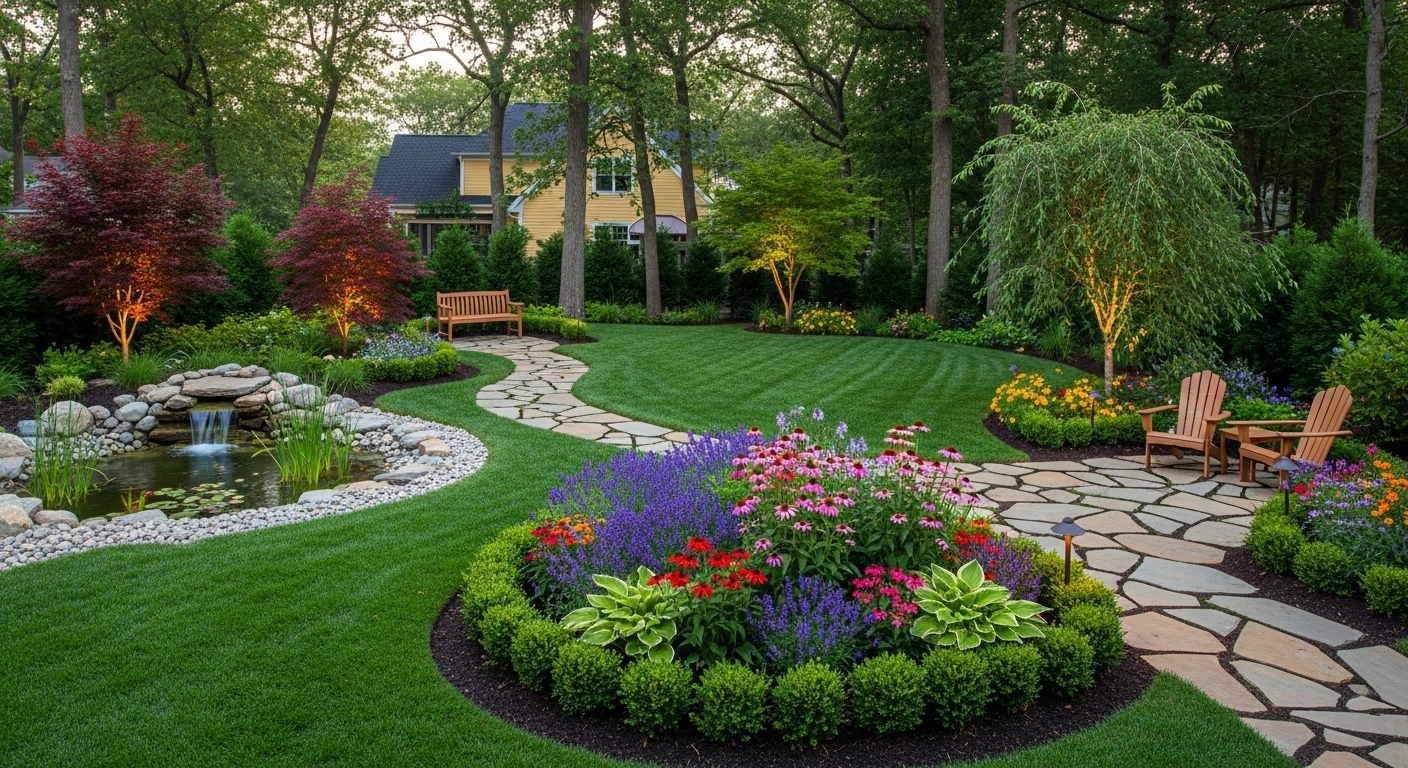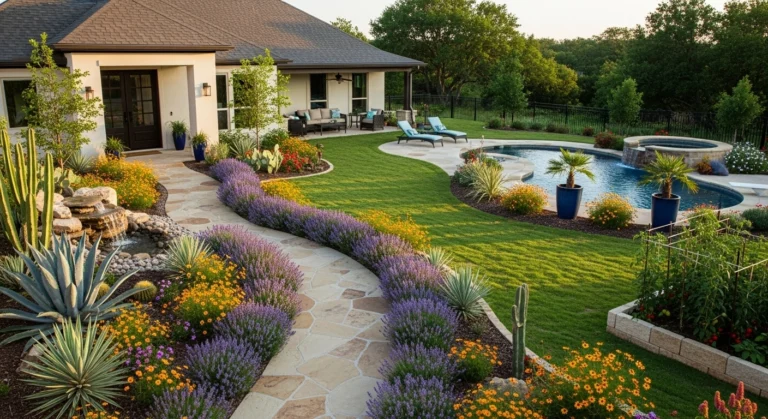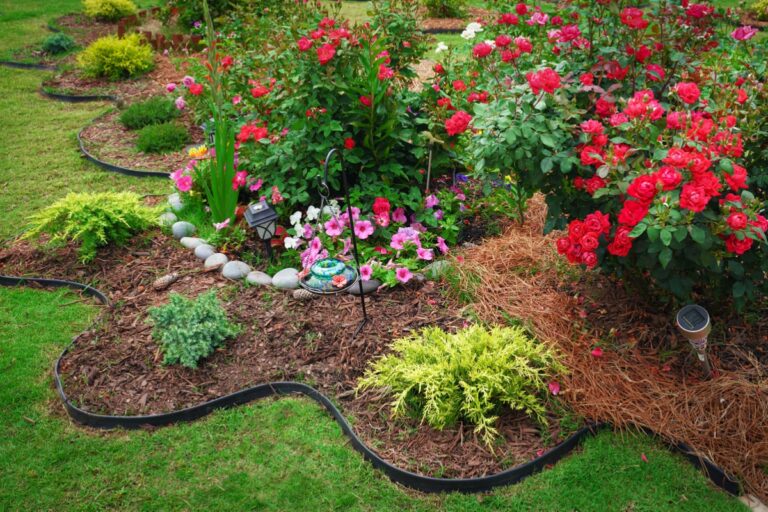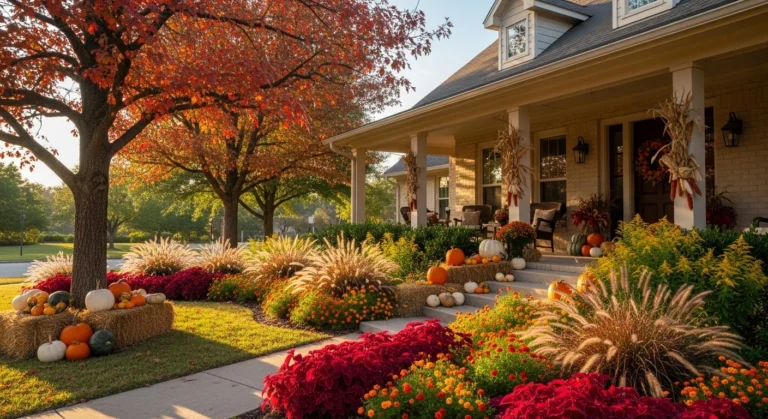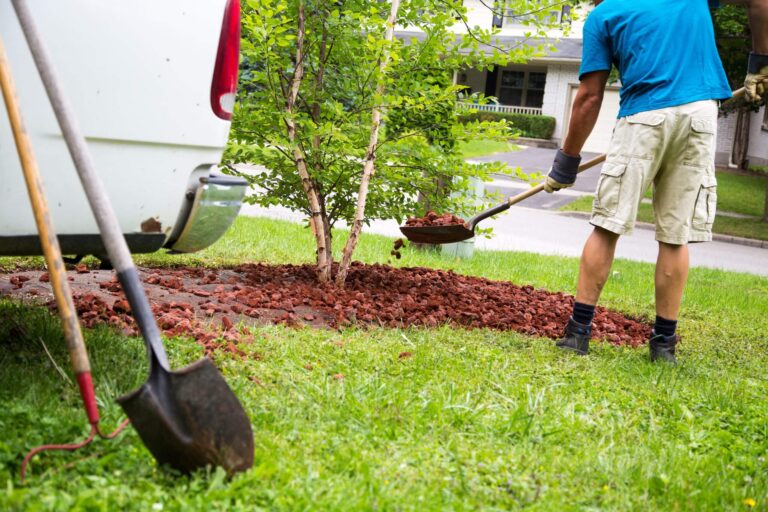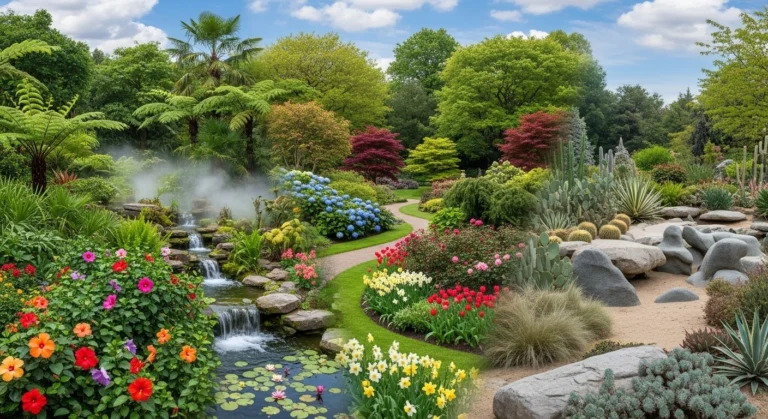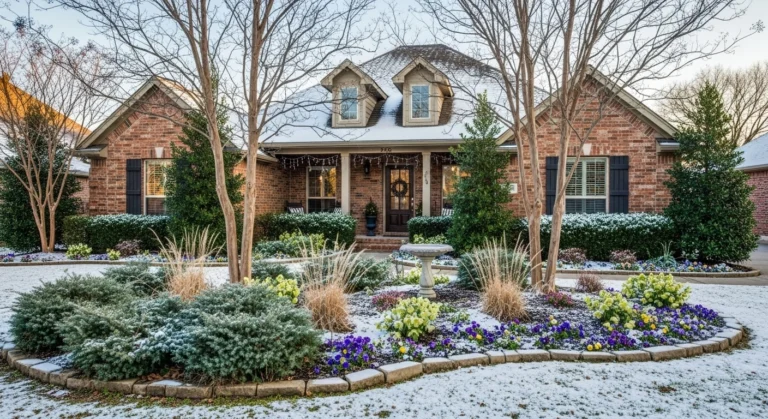Let’s be honest – you’re probably tired of spending every weekend wrestling with your yard, aren’t you? Between watering, weeding, pruning, and replanting, it feels like your landscape has turned into a demanding second job that never gives you a day off. Many Lubbock homeowners find themselves caught in this exhausting cycle, watching their water bills skyrocket while their free time disappears into endless yard work. The worst part? Despite all that effort and money, your landscape might still look stressed, patchy, or downright defeated by our challenging Texas climate.
Here’s the good news: low-maintenance landscaping isn’t just a pipe dream – it’s a smart, strategic approach that can slash your yard work time by up to 75% while cutting your water and maintenance costs significantly. We’ve helped hundreds of Lubbock families transform their high-maintenance outdoor spaces into beautiful, thriving landscapes that practically take care of themselves. The secret lies in working with nature instead of against it, choosing the right plants for our climate, and implementing design principles that eliminate common maintenance headaches. With the right approach, you can have a gorgeous yard that gives you your weekends back and keeps more money in your pocket.
Why Low-Maintenance Landscaping Makes Perfect Sense in Lubbock
Living in Lubbock means dealing with some pretty unique challenges that make traditional landscaping approaches feel like swimming upstream. Our semi-arid climate, intense summer heat, and unpredictable rainfall patterns can turn even the most well-intentioned garden into a constant battle. Add in the alkaline soil conditions and occasional severe weather, and you’ve got a recipe for landscape frustration.
That’s exactly why we’ve become passionate advocates for drought-tolerant landscaping and smart design principles. When you align your landscape choices with Lubbock’s natural conditions, something magical happens – your plants actually thrive instead of merely surviving. We’ve seen homeowners reduce their outdoor water usage by 40-60% while creating more visually striking landscapes than they ever thought possible.
The financial benefits are pretty compelling too. According to recent studies, homeowners can save anywhere from $1,200 to $2,800 annually on water bills, plant replacements, and maintenance costs by switching to low-maintenance design principles. That’s money that stays in your pocket instead of going toward endless plant replacements and sky-high water bills.
Planning Your Low-Maintenance Landscape Design
Start With a Realistic Assessment
Before you start dreaming about your perfect landscape, take a brutally honest look at your current situation. Walk around your property and identify the areas that consume most of your time and energy – these are your prime candidates for transformation. Maybe it’s that patch of grass that never seems to stay green, or the flower beds that require constant replanting.
Site analysis is crucial for success, and we always recommend homeowners consider factors like sun exposure, wind patterns, and existing soil conditions. Lubbock’s intense afternoon sun can be particularly challenging, so identifying microclimates on your property helps you make smarter plant choices. Don’t forget to note areas with good natural drainage versus spots that tend to collect water – this information becomes invaluable during the design process.
Consider your lifestyle honestly too. If you travel frequently or have a packed schedule, your landscape design should reflect that reality. There’s no shame in choosing convenience over complexity – in fact, it’s smart planning that prevents future frustration.
Design Principles That Actually Work
The most successful low-maintenance landscape designs we’ve implemented follow a few key principles that eliminate common maintenance headaches. Grouping plants with similar water and care requirements is probably the most important strategy – it prevents the constant juggling act of trying to meet different plants’ needs in the same area.
Mass plantings create more visual impact with less variety to manage, and they’re incredibly effective in our Landscaping Services projects. Instead of dotting individual plants throughout your landscape, creating bold swaths of the same species or complementary plants reduces maintenance while increasing aesthetic appeal. This approach also helps plants establish stronger root systems as they compete less with neighboring species.
Strategic hardscaping can dramatically reduce your maintenance burden while adding year-round structure to your landscape. Think patios, pathways, decorative rock areas, and retaining walls – these elements never need watering, pruning, or replanting. We often recommend a 60/40 ratio of hardscape to planted areas for truly low-maintenance designs.
Choosing the Right Plants for Lubbock’s Climate
Native and Adapted Plants Are Your Best Friends
Here’s something we’ve learned after years of working in Lubbock’s challenging climate: native plants aren’t just the environmentally responsible choice – they’re the smart financial choice too. Plants that evolved in our region already know how to handle our soil, weather patterns, and seasonal variations without constant human intervention.
Some of our go-to drought-tolerant plants for Lubbock include Texas Red Oak, Agarito, Desert Willow, and various ornamental grasses like Buffalo Grass and Blue Grama. These plants don’t just survive here – they actually look better and require less water than most imported alternatives. We’ve seen homeowners completely eliminate their need for supplemental watering once these plants become established.
Adapted plants – species from similar climates around the world – can also work beautifully in low-maintenance designs. Mediterranean plants like Lavender, Rosemary, and Autumn Sage thrive in our conditions and add wonderful fragrances and colors to the landscape. The key is choosing plants that view our “harsh” conditions as normal, comfortable living.
Plants to Avoid for Low-Maintenance Success
Let’s talk about the plants that look gorgeous at the nursery but turn into maintenance nightmares in Lubbock yards. High-water plants like most traditional annuals, Azaleas, and Hydrangeas might survive here with intensive care, but they’ll demand constant attention and inflate your water bills significantly.
Invasive or overly aggressive spreaders can quickly turn your low-maintenance dream into a containment nightmare. Plants like Bamboo, English Ivy, and even some ornamental grasses can escape their intended boundaries and create ongoing management issues. We always research a plant’s growth habits before recommending it for low-maintenance installations.
Plants prone to pest or disease issues in our climate should also be avoided, even if they’re otherwise low-maintenance elsewhere. Some roses, certain fruit trees, and plants that struggle with our alkaline soil conditions will require ongoing treatments and interventions that defeat the purpose of low-maintenance design.
Creating Plant Communities
One of the most effective strategies we use in our Landscaping Design Guide is creating plant communities that support each other naturally. This biomimetic approach groups plants that would naturally occur together, creating ecosystems that require minimal outside intervention once established.
For example, pairing deep-rooted plants with shallow-rooted species allows them to access water at different soil levels without competing directly. Nitrogen-fixing plants like Desert Willow can actually improve soil conditions for their neighbors, reducing the need for fertilizers and soil amendments over time.
Ground cover plants play a crucial role in these communities by suppressing weeds, retaining soil moisture, and protecting the soil surface from temperature extremes. Native options like Trailing Lantana or Buffalo Grass can eliminate the need for mulch in many areas while providing attractive, functional coverage.
Water-Smart Irrigation and Design Strategies
Efficient Irrigation Systems
Even in a low-maintenance landscape, you’ll likely need some irrigation system, especially during establishment periods and extreme weather events. Drip irrigation systems are hands-down the most efficient choice for most planted areas, delivering water directly to root zones with minimal waste through evaporation.
We typically recommend smart irrigation controllers that adjust watering schedules based on weather conditions, soil moisture, and seasonal needs. These systems can reduce water usage by 20-30% compared to traditional timer-based controllers while ensuring plants receive appropriate moisture levels. The technology has improved dramatically in recent years, and many systems can be controlled remotely through smartphone apps.
Zoning your irrigation based on plant water requirements is essential for efficiency. High-water zones might include vegetable gardens or seasonal color areas, while drought-tolerant zones require minimal supplemental irrigation once established. This targeted approach prevents overwatering adapted plants while ensuring higher-maintenance areas receive adequate moisture.
Natural Water Management
Rainwater harvesting doesn’t have to be complicated – even simple strategies like directing downspouts toward planted areas can significantly reduce irrigation needs. We often design landscapes that naturally channel rainwater toward root zones, using gentle slopes and swales to maximize the benefit of natural precipitation.
Mulching strategies can dramatically improve water retention while reducing weed pressure and soil temperature extremes. Organic mulches like wood chips break down over time, improving soil structure, while inorganic options like decomposed granite provide permanent coverage with zero maintenance. The key is choosing mulch materials that complement your overall design aesthetic.
Permeable hardscaping allows rainfall to penetrate into the soil rather than running off into storm drains, reducing both irrigation needs and potential drainage problems. Permeable pavers, decomposed granite pathways, and strategically placed gravel areas can handle foot traffic while supporting overall water management goals.
Design Elements That Minimize Maintenance
Strategic Use of Hardscaping
Hardscaping elements are the backbone of any truly low-maintenance landscape design. Patios, walkways, retaining walls, and decorative rock features provide year-round structure and visual interest without requiring any ongoing care beyond occasional cleaning.
We particularly love using natural stone and decomposed granite in Lubbock landscapes because they complement our natural environment while standing up beautifully to our weather extremes. These materials age gracefully and often look better after a few years of weathering than they did when first installed.
Outdoor living spaces serve double duty by reducing the planted area while creating functional spaces for relaxation and entertainment. A well-designed patio or deck can eliminate high-maintenance lawn areas while adding significant value to your property. We often recommend covering 30-40% of smaller yards with attractive hardscaping to minimize ongoing maintenance demands.
Smart Ground Cover Choices
Replacing traditional lawn grass with appropriate alternative ground covers can eliminate one of the most maintenance-intensive aspects of conventional landscaping. Buffalo grass and native bunch grasses provide attractive coverage with minimal water and mowing requirements compared to traditional turf varieties.
For areas where foot traffic isn’t a concern, low-growing perennial plants like Autumn Sage, Trailing Lantana, or various sedums can create beautiful living carpets that suppress weeds naturally. These plants typically require establishment watering for the first season, then thrive on natural rainfall alone.
Inorganic ground covers like decorative gravel, river rock, or decomposed granite work beautifully in contemporary designs and require virtually zero maintenance once installed. We often use these materials to create attractive transitions between planted areas and hardscaping elements.
Reducing Lawn Areas
Let’s address the elephant in the yard – traditional lawn grass is probably the most maintenance-intensive element in most landscapes. Between mowing, edging, fertilizing, and watering, lawn care can consume enormous amounts of time and resources, especially in our challenging climate.
Strategic lawn reduction doesn’t mean eliminating grass entirely, but rather limiting it to areas where it serves a specific functional purpose. We often recommend maintaining smaller lawn areas for children’s play or entertaining while replacing decorative lawn areas with more appropriate alternatives.
Lawn alternatives that work beautifully in Lubbock include native bunch grasses, groundcover plants, and attractive hardscaping. These alternatives often provide more visual interest than traditional turf while requiring a fraction of the ongoing maintenance and water resources.
Ready to transform your high-maintenance landscape into a beautiful, efficient outdoor space? Contact Lawn Care Lubbock today to discuss your low-maintenance landscaping goals and discover how we can help you create a landscape that saves both time and money.

